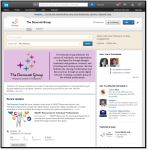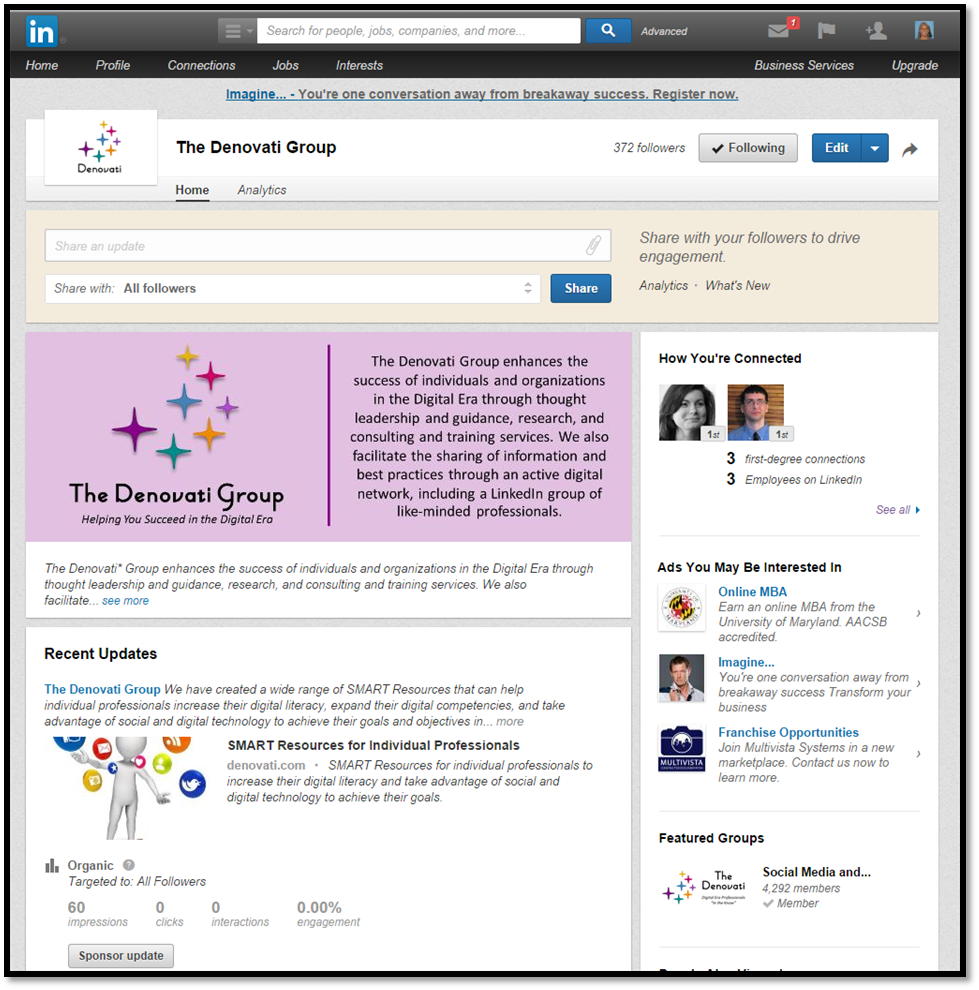 LinkedIn Company Pages once held a lot of promise, but their value has becoming increasingly limited over time. Most organizations can now probably either live without them or restrict their usage to a simple organizational profile. This post assesses the past and current state of the feature and offers guidance on the most practical ways to leverage it.
LinkedIn Company Pages once held a lot of promise, but their value has becoming increasingly limited over time. Most organizations can now probably either live without them or restrict their usage to a simple organizational profile. This post assesses the past and current state of the feature and offers guidance on the most practical ways to leverage it.
Just about three years ago I extolled the virtues and potential value of LinkedIn Company Pages, referring to them as “an undervalued gem for organizations of all types.” I began that piece by writing:
LinkedIn’s “company” management capability is an amazingly powerful and surprisingly underutilized feature of the platform. Other than the Careers functionality, the feature is free. And even though LinkedIn uses the term “company,” it’s a feature that can be used by organizations of all types, as well as organizations of any size (including solopreneurs).
I went on to highlight some of the benefits of LinkedIn Company Pages, including how they enable organizations to:
- Connect all employees on LinkedIn under a single employer identity
- Promote the organizational brand, products and services
- Communicate the employment brand and enhance recruiting efforts
- Facilitate business development and other efforts to garner support from outside parties
- Provide an easier mechanism for externally facing employees (e.g., business development, recruiting) to be found via LinkedIn
- Connect LinkedIn users to their website and other internet presences
Even as recently as a year ago, I heard a representative from LinkedIn promoting LinkedIn Company Pages in a Social Media Week presentation (see slides 17-23 in this deck).
But much has changed in the past year, and the LinkedIn Company Pages feature has gotten stripped down to a few essential elements that don’t offer a lot of potential value for most organizations.
What’s Gone from LinkedIn Company Pages
Probably the biggest element that has been removed from LinkedIn Company Pages is the Products and Services tab, which was deactivated in April 2014. Organizations used to be able to create sub-pages for each of their key offerings. These sub-pages included a description of each featured product or service (with or without a disclaimer), a related image and web page link, a designated contact, a YouTube video, and a special offer or promotion (which also appeared on the main page). The feature also enabled clients and other stakeholders to provide endorsements for specific products and services (via a virtual “thumbs up”), as well as testimonials. All of that is now gone.
A number of related features on the main company page have been eliminated as well, including the ability to:
- Create multiple versions of the page for different audiences and/or market segments
- Add up to three linkable banners that will rotate through the page
- Link to a YouTube video
- Feature specific products and services
- Include an RSS feed from a company blog
- Incorporate a general disclaimer
LinkedIn Company Pages: What Remains?
Free Features. The basic profile aspect of LinkedIn Company Pages remains essentially unchanged. Organizations can provide a brief overview of who they are and what they do, identify specialties, link to a website, and share simple demographics like industry and company size. They can also list up to three featured LinkedIn groups on their profile.
Group administrators can also use the company status update feature to link to blog posts, YouTube videos, SlideShare documents, and other created and curated content. The feature can also be used to promote products and services, provide special offers, feature employees and clients, etc.
In place of the Products and Services feature, LinkedIn enables organizations to create up to 10 showcase pages. Although these pages are “children” of the main parent page, they are treated as independent, which means they have their own profiles, followings and updates.
And of course it’s still possible to have employees and contractors their individual profiles to the company page so visitors can see at a glance who’s currently affiliated with the organization and what their roles are.
Premium Features. Any organization can post a job for 30 days (the rate I was just quoted for Chicago was $395) and have that job linked to their company profile. They can also pay for sponsored updates, which is effectively targeted advertising, using either a pay-per-click or pay-per-view pricing model. And of course it’s possible to add a Careers page to the company profile.
LinkedIn Company Pages: What’s an Organization To Do?
In addition to the fact that the features of LinkedIn Company Pages have been stripped down, gaining page followers (for both the main and showcase pages) requires a lot of effort. And even if an organization is able to acquire them, that doesn’t mean they’ll be able to reach – let alone engage – them by providing status updates (at least not organically). Although The Denovati Group provides a status update almost daily, for example, our average organic reach is less than 30% and our average engagement is close to zero. I expect those results are typical.
If an organization wants to reach and engage more people, from either a business development or a hiring perspective, it’s going to have to pay. That’s certainly fair – LinkedIn is, after all, a for-profit company – but it does raise important ROI questions.
All things considered, are LinkedIn Company Pages still worthwhile? Perhaps, to an extent. Here are my thoughts for organizations of different sizes.
Tiny: For sole proprietors, small partnerships, and organizations with fewer than 10 employees, a company page may not be worth the effort to try to maintain, and may even undermine the brand and the company’s goals and objectives. Leaders and other individuals in small organizations are probably better off developing robust LinkedIn profiles and using their individual status updates and the blog feature to promote their expertise, thought leadership, and brand(s), as well as their products and services.
Kathy Caprino, the Founder of Ellia Communications, is a good case in point. Her company page has only 108 followers, but over 24,000 people follow her as an individual. Although she seems to have wisely put her energy into maintaining a strong individual presence on LinkedIn, and only has a basic company page, the anemic nature of that page may be doing her more harm than good. I would advise her to consider getting rid of it.
Small to Medium: As an organization grows in size, there could be some value in having a basic company page, if for no other reason than to connect the individual profiles of employees. And if the resources are available, providing regular – or even occasional – status updates can be worthwhile. Although the reach and engagement may be low when the messages are posted, there can be some value in having these updates available to people who visit the page.
Examples of small to medium organizations that take this approach include ViaForensics, YouEarnedIt, RightPoint, SWC Technology Partners and Varsity Tutors. Although they all provide (semi)regular status updates, none of them have either showcase pages or career pages, and only some of them have posted jobs.
A word of caution: With a small amount of additional effort, you can customize status updates for LinkedIn Company Pages so they don’t look like bastardized tweets (e.g., by including hashtags and unnecessary abbreviations) or show a lack of care (e.g., not deleting the url for a link after the image and excerpt render).
Large: LinkedIn Company Pages make the most sense for organizations that have both large employee populations and large followings. And of course they have the resources to both support and effectively leverage showcase pages, as well as premium features like job postings, sponsored updates, and careers pages. They are also able to connect the pages of various subsidiaries (e.g., Microsoft’s Yammer, Ford’s credit division).
I looked at a number of LinkedIn Company Pages for large organizations, like Google, IBM, Microsoft, Waste Management, and the U.S. Department of State. Interestingly, although they had relatively large followings and used many of the advanced features of company pages, none of them provided frequent status updates. Curious…
Also interesting is the fact that many large public sector organizations, like the cities of New York and Chicago, still have anemic LinkedIn Company Pages. Granted, there are also pages for specific units like the fire and health departments, but none of these pages are linked.
Final Thoughts
I’ve been thinking about the value of LinkedIn Company Pages ever since a recent digital coaching session in which I advised a “single-shingle” professional that it probably wasn’t worth her time or effort to create and maintain one. After giving her that advice, I’m still trying to decide whether we should continue to have one. We get almost no return on it, but our additional investment at this point is minimal (less than a minute per day to share an update), so far now I’ll stick with it.
As always, I welcome your feedback. What questions has this piece raised for you? What would you add to, change, or delete from my assessments and recommendations?





Leave a Reply
You must be logged in to post a comment.